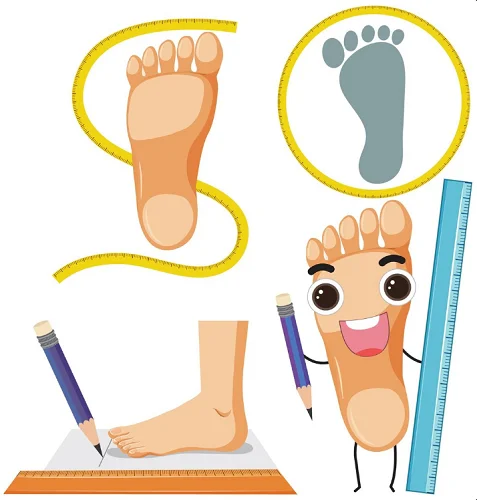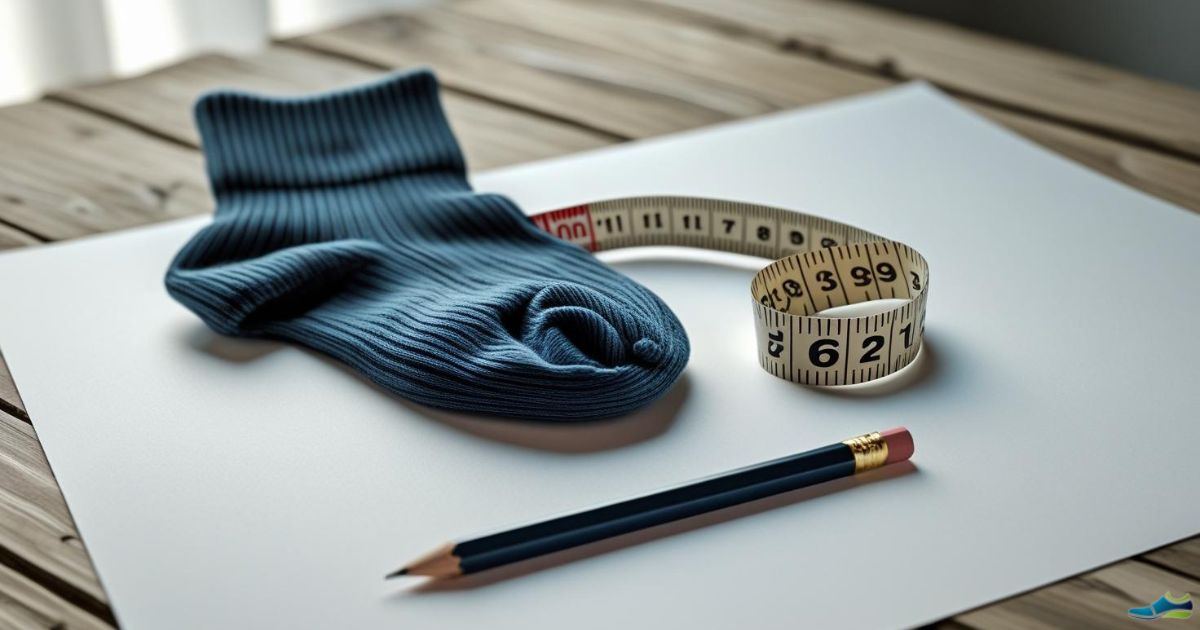Most people know their shoe size in length, but few know their true width. That’s why so many pairs feel fine in the shop, only to pinch after a few hours of wear. Measuring your foot width at home is quick, simple, and gives you the numbers you need to shop smarter. With just a ruler, paper, and five minutes, you’ll find out if your feet are narrow, standard, wide………or wider than you thought
If you already know your measurements and width size, there’s more information on my Complete Wide Fit Shoes Guide
Step 1: Gather your Materials
You don’t need fancy equipment. Most of these items are probably already around your house:

A flat and even floor
A piece of paper (big enough to fit your foot)
A pen or pencil
A ruler or measuring tape (in centimetres or inches)
A pair of socks like the ones you usually wear
Having everything ready makes it easy and helps you get the most accurate measurement.
Step 2: Prepare Your Feet and Workspace
Measure your feet at the time of day when they’re at their largest, which is usually late afternoon or evening, since your feet naturally swell as the day goes on. Getting a realistic measurement means your new shoes won’t pinch when your feet are at their biggest.
- Wear the type of sock you normally would with the shoes you’re planning to buy (thin socks for dress shoes, thicker ones for trainers or boots).
- Put your sheet of paper on an even, hard floor. Avoid carpet, as it makes it difficult to draw and can mess with the outline.
- If you have swelling issues, measure when it’s at its worst for the most accurate results.
Step 3: Trace Your Foot
This part is straightforward, but a good outline makes all the difference:
- Stand upright with your foot flat on the paper. Distribute your weight evenly for the best measurement. If you can, ask someone to help with tracing, which can result in a more precise outline.
- Holding the pen or pencil straight up (not angled), trace around your entire foot, keeping the pencil tight against your foot but not tilting underneath your arch.
Repeat this for your other foot. It’s very common for one foot to be wider than the other, so don’t worry.
Always shop for shoes that match your wider foot for the best comfort.
Step 4: Measure the Widest Part
For most people, the widest part of the foot is the ball, just below the toes.
- With your traced outline on the paper, you will be able to see the two biggest bulges near the ball of your foot (right before the base of your toes). These are usually just below your big toe and your little toe.
- Use your ruler or tape measure to measure the straight line distance between these two points, straight across the width of your outline. Write down this measurement in inches or centimetres.
If you notice your foot is unusually higharched or flat, take note if your foot spreads more when you put weight on it. This can also affect your shoe fit. Read more about Flat Feet Solutions.
Step 5: Compare Your Measurements to Shoe Width Charts

Shoe brands nearly always provide a sizing chart for both length and width. Typical adult width sizing includes “N” (narrow), “M” or “D” (medium/standard), “W” or “2E” (wide), and “WW” or “4E” (extra wide). Each brand has its own actual dimensions, so checking their width chart is super important.Go to the brand’s website or a trusted shoe retailer online.
Find the shoe width conversion chart and match your width measurement to their listed sizes.
If you’re between sizes, it’s generally more comfortable to size up for width. Shoes that are too narrow lead to more discomfort than shoes that feel a little roomy.
Once you’ve measured your width, the next step is understanding what those numbers mean. Check out our Wide Shoe Widths Explained guide to decode UK, US, and EU width systems and find your perfect fit.
I also recommend taking a peek at my Do I need Wide Fit Shoes? Guide.
Troubleshooting Measurement Issues
What if my feet are two different widths?
This situation is actually pretty common. Use the measurement from your wider foot when choosing shoes you’ll be wearing all day. Some speciality shoes allow for mismatched pairs, but when that’s not an option, always prioritize comfort for the larger foot.
My outline looks lopsided, am I doing it wrong?
This might happen if your foot moved during tracing or if the pen angle changed. Try repeating the process, making sure to stand still and hold the pen upright. Having a friend help often results in a more accurate outline.
I don’t have a ruler or tape measure. What can I do?
If you have a printer, print out a ruler using an online template. Otherwise, use anything with a known length, like a credit card (about 3.37 inches wide), to estimate your measurement.
Extra Tips for Accurate Foot Width Measurement
- Always measure both feet each time. Foot size and width can change with age, changes in weight, or even temperature.
- Take measurements at least twice and use the average if you get different numbers.
- Write down both length and width—many shoe retailers ask for both, especially if you need a tailored fit.
- If you’re eyeing speciality footwear like running shoes, look up the brand’s recommended sizing as some suggest a roomier fit for proper movement.
The more often you check, the more you’ll notice subtle changes in your feet. Once you learn how to measure foot width at home, especially if you’re mostly shopping online, it will help to avoid hassle with returns.
Foot pain rarely comes from just one cause — it’s usually a mix of load, footwear, and lifestyle.
For a deeper look at prevention and recovery, explore The Complete Guide to Foot Pain Relief
Frequently Asked Questions
Does sock thickness make a difference?
Absolutely. That’s why you want to measure your feet while wearing the type of sock you plan to pair with that set of shoes. The thickness can definitely impact your results.
Should I remeasure if I gain or lose weight?
Yes. Your foot size and width can change with weight loss or gain, so update your measurements accordingly before shopping for new shoes. Learning how to measure foot width is a skill that will serve you for a lifetime.
How does measuring kids’ foot width work?
The same steps apply to kids’ feet. Just be prepared to measure them more often since their feet can grow fast. It’s normal to check every couple of months for children.
Key Takeaways and Next Steps
Measuring your foot width at home is quick and super useful for finding footwear that fits perfectly. All you need is some paper, a pencil, and a ruler. Doublecheck your measurements more than once, use your wider foot as your reference, and take advantage of brand sizing charts when you’re ready to buy. Saving your measurements is a great idea, especially for future online shopping.
Your Action Plan:
- Gather your measuring materials and pick the best time of day (afternoon or evening).
- Trace both feet and measure the widest part accurately.
- Match your numbers with shoe size charts to settle on a width that truly suits you.
If you just checked your foot measurements for the first time, you are on your way to having the best fitting shoes ever!
Taking a little time to measure now will really pay off comfort wise, no more struggling to find shoes that fit when you are rushing to go out. Give it a try before your next shoe purchase—you might be surprised at your actual fit!

Taking a little time to measure now will really pay off comfort wise, no more struggling to find shoes that fit when you are rushing to go out. Give it a try before your next shoe purchase—you might be surprised at your actual fit!
And Remember…..Comfy Feet are Happy Feet
My Best Wide Fit Shoes for Comfort Guide is a real help once you decide on new footwear
Once you’ve got your measurements, our Wide Fit Shoes Guide helps you match your size to real-world shoe styles.

